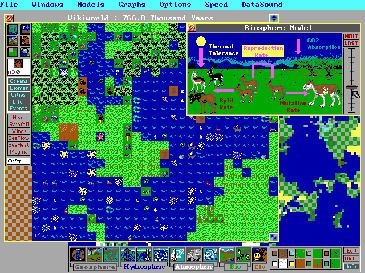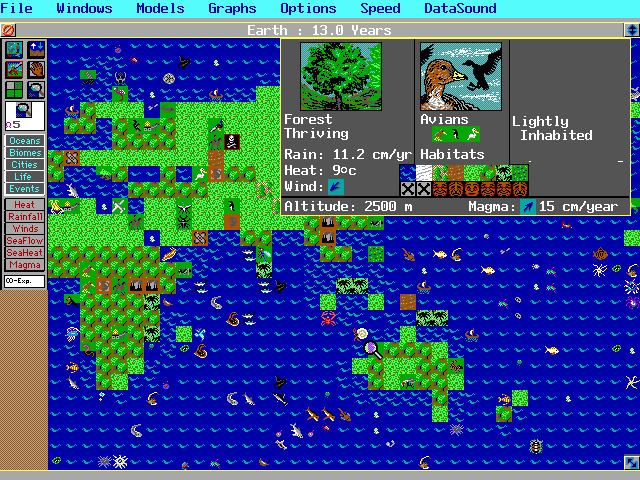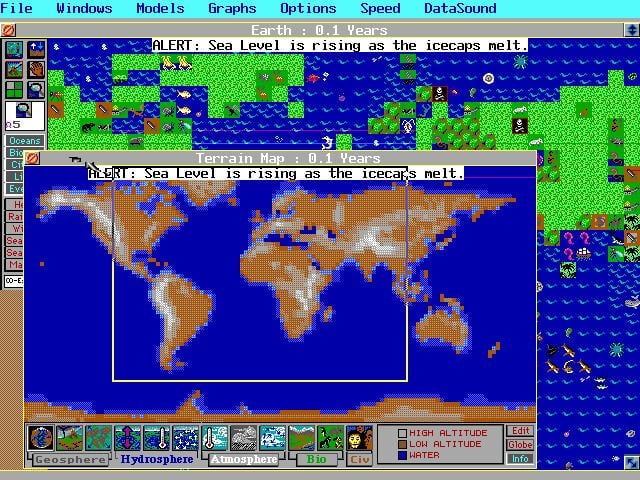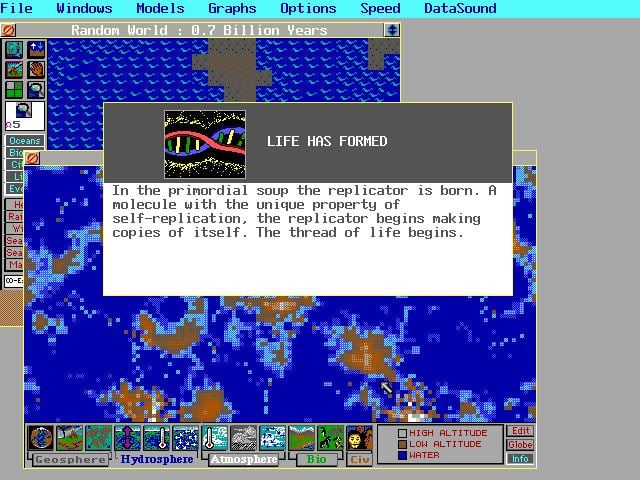8.6 /10 1 Votes8.6
3.7/5 Abandonware DOS | 4.4/5 My Abandonware 4.9/5 Emuparadise Initial release date 1990 | |||||||||||||||||||||||||||||||||
 | ||||||||||||||||||||||||||||||||||
Similar Maxis games, Life simulation games, Other games | ||||||||||||||||||||||||||||||||||
Simearth the living planet game sample turbografx cd
SimEarth: The Living Planet is the second life simulation video game designed by Will Wright, in which the player controls the development of a planet. The game was published in 1990 by Maxis. Versions were made for the Apple Macintosh, Commodore Amiga, IBM PC, SNES, Sega Mega-CD and TurboGrafx-16. It was also subsequently re-released on the Wii Virtual Console.
Contents
- Simearth the living planet game sample turbografx cd
- Simearth the living planet snes 60fps
- Overview
- Taxa
- Reception
- References

Simearth the living planet snes 60fps
Overview

In SimEarth, the player can vary a planet's atmosphere, temperature, landmasses, etc., then place various forms of life on the planet and watch them evolve. Since it is a software toy, the game does not have any required goals. The big (and difficult) challenge is to evolve sentient life and an advanced civilization. The development stages of the planet can be restored and repeated, until the planet "dies" ten billion years after its creation, the estimated time when the Sun will become a red giant and kill off all of the planet's life.

The game models the Gaia hypothesis of James Lovelock (who assisted with the design and wrote an introduction to the manual), and one of the options available to the player is the simplified "Daisyworld" model.

The player's control of the planet in the game is quite comprehensive; display panels allow the player to regulate everything from atmospheric gases, with percentages to three decimal places, to the rate of continental drift, to the rate of reproduction and mutation of lifeforms. In addition, the player is given options to place equipment or items that interfere with the planet's development, such as Oxygen Generators, which increase the amount of oxygen in the atmosphere, and the monolith, a take on the one found in 2001: A Space Odyssey, which aids in increasing intelligence of a lifeform through extraterrestrial contact.
The list of disasters ranges from natural occurrences, such as hurricanes and wild fires, to population-dependent disasters, such as plagues and pollution. Effects on the planet may be minor or major depending on the current conditions. Increased volcanic eruptions, for example, increase the amount of dust in the atmosphere, lowering global temperature; earthquakes in a body of water may produce tsunamis; and the shortage of nuclear fuel for a nuclear power-dependent civilization may potentially trigger nuclear war.
All player-triggered actions have a cost specified in "energy units" or "omega (Ω) units"; for example, 50 energy units are required to lay down a single terrain square, while 500 units are required to lay down a terraforming device. The energy budget is determined by the level of development of the planet, and the chosen difficulty level; on the lowest difficulty level, the energy budget is unlimited.
Gameplay itself can be somewhat mystifying; species may thrive or die out for no apparent reason. Mass extinctions, however, are often followed by periods of renewed evolutionary diversification, allowing the player to experiment with new sets of species and ecosystems.
Taxa
A feature of the game is that all taxa of multicellular animals are on an equal footing, and thus it is possible to evolve, for example, sapient molluscs. The two single-celled lifeform taxa, Prokaryotes and Eukaryotes (or Bacteria and Amoebas, in-game respectively) are treated specially. Some examples of animal taxa include Radiates and Cetaceans as well as more well known taxa such as fish and birds. As an "Easter egg", there is also machine life, which can appear if a city of the highest technology level (Nanotech Age) is destroyed by a nuclear explosion. Machine life can thrive in any biome or environmental conditions, generally out-competing any other lifeforms present, and can itself eventually evolve intelligence and build cities. Additionally, there are Carniferns, which are mutated, carnivorous plants, which can occur only naturally. Having an abundance of insects allows for these life-forms to develop. Carniferns are able to develop intelligence just as animals can. In addition to the familiar types, the long-extinct "trichordates" are included. The game states that "We [the game's developers] felt sorry for them, and are giving them a chance for survival in SimEarth." Dinosaurs are also an included taxa.
Reception
Computer Gaming World called SimEarth "absolutely fascinating". The reviewer wished that the game had more SimCity-like visual feedback, but stated that it was superior to the predecessor because of larger scope and greater replayability. It won the 1991 Software Publishing Association Excellence in Software Awards for Best Secondary Education Program and Best Simulation Program.
